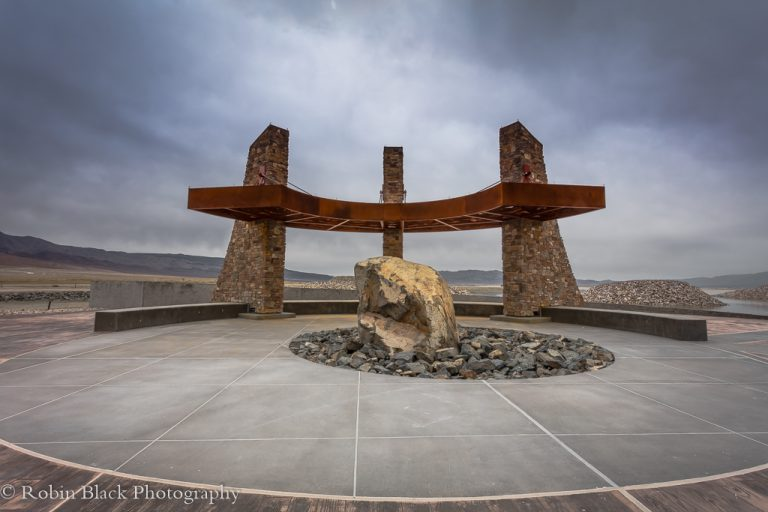Will Barons of Blue Water be More Equitable than those of Black Oil?

http://www.owenslakeproject.com/ This photo was posted in The Lake on April 28, 2016.
Many of today’s under-resourced communities have no more access to blue gold (scarce water) than the under-resourced white residents of the Owens Valley have had since the 1920s. In 1924 greedy public and private water interests transformed the lush Owen’s Lake into a noxious dust bowl.
One of the guilty parties LADWP (Los Angeles Department of Water and Power), recently celebrated partial restoration of Owens Lake by constructing a ghostly monument of granite and sculpted earth in the long desiccated lake bed. The monument includes a public plaza with curved granite walls inspired by the wing shapes of ghostly shorebirds and eerie sculptures of earth and rock reminiscent of the whitecaps that once graced the lake’s watery surface.
For many indigenous peoples denied their rights to water for a century, partial restoration of the lake without full restoration of their water rights is too little, too late. As LADWP slowly restores water to the Lake, only one Paiute tribe (Paiute means “flowing water”) in Fort Independence is well positioned to benefit from increased water flows. That tribe never gave up its right to water that it uses to operate an orchard and other businesses, and maintains the community base needed to profit from increased water allocations.
After the 1920s most of the Paiute tribes lost ownership of Owens Valley water and the opportunity to own orchards, alfalfa fields and businesses. Now, they, and many of California’s agriculture workers, servers, cooks, hotel maids and domestic workers, struggle to reliably access clean safe water for their own homes and businesses.
When black and Latino under-resourced neighborhoods, whether in the Central Valley or in Compton, have water, it is often unattractive, or even contains toxic metals or pesticides. In the case of Sativa (Compton), a private water company, which had to be dissolved and management taken over by Los Angeles County Waterworks Districts , a brown, smelly fluid flowed from faucets. Daniel Lafferty, an engineer at the county’s Department of Public Works, described the fluid “as disgusting, but safe.”
To correct such inequities in access to natural resources between counties, state and local governments increasingly give new affordable housing developments preferential access to local water and land. Residents often object to such preferential access, including some in San Mateo County’s Midcoast a few miles south of San Francisco.
Some residents, like the LA water grabbers of the 1920s, are considering legal options that would keep lower income workers and their families from accessing water and land promised to them by the Montara Water and Sanitary District and San Mateo County in Policy 3.15 of its Local Coastal Program Policies approved by the California State Coastal Commission. Unlike LA’s water grabbers in the 1920s, who ignored environmental concerns, today’s suited protectors of land, water and neighborhood characters often attempt to greenwash their sentencing of lower income workers to long commutes with dubious environmental claims.
Legitimate problems and benefits of housing for low-income workers in a semi-rural area along the Pacific Coast will be aired at a public hearing on Friday, March 12th, when the California Coastal Commission will consider San Mateo County’s request to approve Amendment No. LCP-2-SMC-20-0054-1 for the Cypress Point Affordable Housing Project to amend a LDP (Local Development Permit) to site 70 affordable homes in the Cypress Point development in Moss Beach. Especially if you live along the Pacific Coast, get involved, attend the virtual commission meeting and let your voice be heard.
Today, as private investors acquire more rights to California water, exploitive water barons may replace the railroad and oil barons who dominated California politics for a century. Numerous would-be barons of blue gold are attracted to water, as climate change and population growth drives its price higher and the price of black gold-oil falls.
Take action to ensure that California governments supply water sustainably and equitably. Take action to prevent emerging water barons from gaining monopolistic control of California’s water sources.
Take action and sign up for the Sierra Club California Environmental and Social Justice Newsletter put out by the SCC Committee for Environmental and Social Justice by e-mailing your request to CNRCC-EJ@lists.sierraclub.org.
William Smith
Co-chair, Sierra Club California Conservation Committee for Environmental and Social Justice Committee
(SCC - E&SJComm)
If you’re interested in working on environmental and social justice issues please contact me at: smithwja@gmail.com
For water issues contact Charming Evelyn at: bcharmz@aol.com
Co-Chair Sierra Club California Conservation Committee for Water (SCC-WatCom)
This link, http://www.coastal.ca.gov/meetings/agenda/#/2021/3, will only be valid until March 13th, when the 4 day California Coastal Commission meeting ends. After that check for their March 12th meeting agenda in the Commissions meeting archives.
Blog Category:



Add new comment